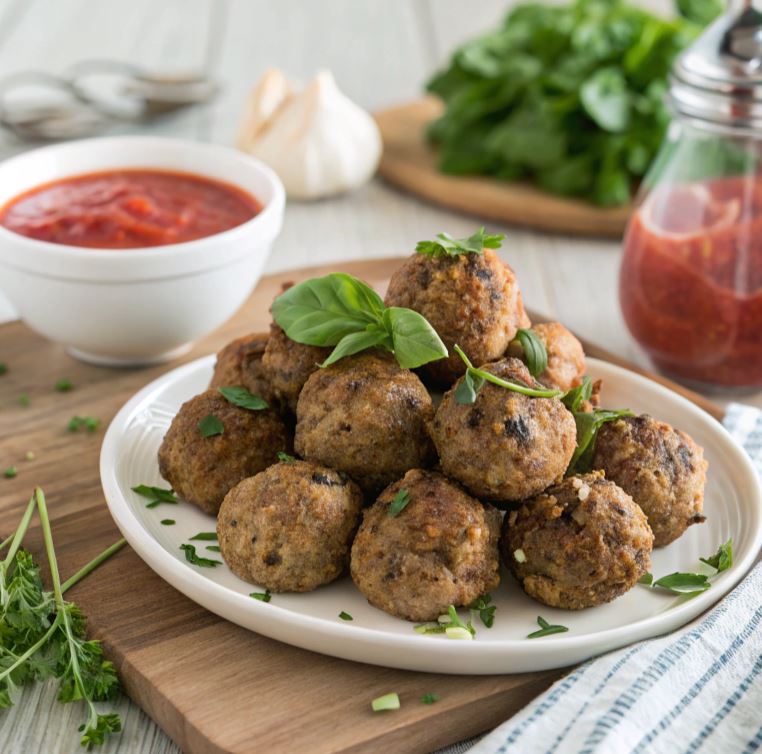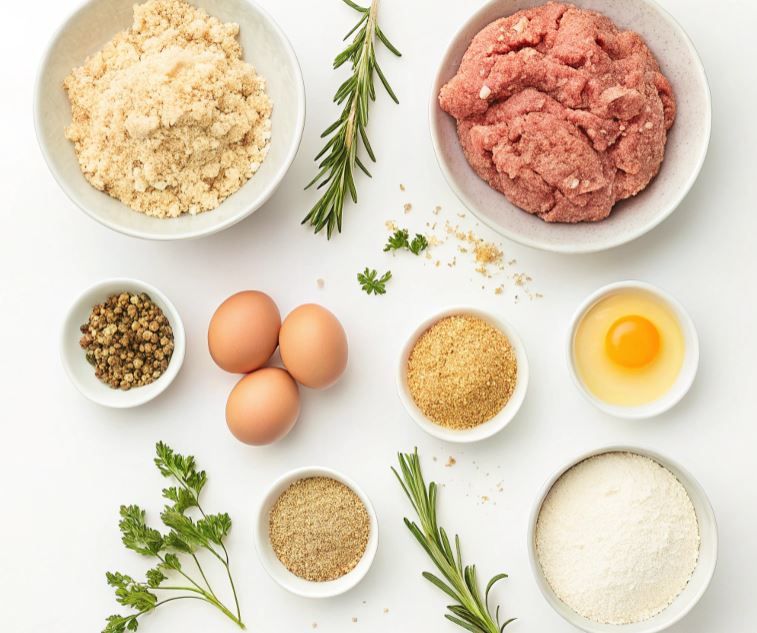Gluten-Free Meatballs offer a delicious and wholesome alternative for those with dietary restrictions. Whether avoiding gluten due to celiac disease or personal preference, these meatballs provide the same satisfying taste and texture as their traditional counterparts. By carefully selecting ingredients and employing proper cooking techniques, home chefs can achieve flavorful and tender meatballs without relying on breadcrumbs containing gluten.

This article delves into the history, ingredients, and preparation of Gluten-Free Meatballs, offering expert tips to ensure they turn out perfectly every time. Additionally, it explores the health benefits of this dish, how to make it appealing to children, and the best serving suggestions. By following this comprehensive guide, readers can master the art of crafting delicious and nutritious meatballs suitable for any occasion.
History and Origins of Gluten-Free Meatballs
The concept of Gluten-Free Meatballs has evolved alongside the broader history of meat-based dishes. Traditional meatballs, found in cuisines worldwide, often include breadcrumbs as a binder. However, long before gluten became a concern, many cultures used alternative ingredients to achieve similar results.
In Italian cuisine, polpette often included stale bread soaked in milk, while Middle Eastern kofta relied on herbs and spices to hold the mixture together. Scandinavian varieties featured a blend of meats and potatoes. Historically, necessity drove culinary innovation, leading to naturally Gluten-Free Meatballs in many regions.
As awareness of gluten sensitivities and celiac disease grew, chefs and home cooks adapted their recipes. The demand for gluten-free alternatives has led to innovative substitutions such as almond flour, ground oats, and even mashed vegetables. Today, Gluten-Free Meatballs are not only a dietary necessity for some but also a flavorful option enjoyed by many.
Gluten-Free Meatballs Around the World
Gluten-Free Meatballs are enjoyed in various forms across different cultures, each incorporating unique flavors and ingredients. In Italy, polpette are often made with a combination of meats, herbs, and cheese, sometimes served without breadcrumbs for a naturally gluten-free version. The Middle East is known for kofta, a spiced meatball alternative that relies on fresh herbs and onions rather than gluten-based binders. In Sweden, köttbullar are commonly paired with lingonberry sauce and mashed potatoes, and gluten-free versions use potato starch as a binding agent. In Asian cuisine, meatballs are often found in soups or dumplings, with gluten-free variations incorporating rice flour or cornstarch. These global interpretations highlight the versatility of Gluten-Free Meatballs, making them a staple in many diets worldwide.
Detailed Ingredients for Gluten-Free Meatballs
Creating delicious Meatballs requires high-quality ingredients that enhance both taste and texture. Selecting the right components ensures a balanced flavor profile and a tender bite.
Essential Ingredients:

- Ground meat (beef, turkey, chicken, or pork)
- Binding agents (almond flour, ground flaxseed, or gluten-free breadcrumbs)
- Eggs for moisture and structure
- Seasonings (garlic, onion powder, paprika, oregano, or basil)
- Dairy or dairy alternatives (grated Parmesan or nutritional yeast)
- Fresh herbs (parsley or cilantro for freshness)
- Salt and pepper to enhance taste
Optional Additions:
- Finely chopped vegetables (mushrooms or zucchini for extra moisture)
- A dash of Worcestershire sauce (ensure it is gluten-free)
- Shredded cheese for a richer flavor
By combining these ingredients in precise proportions, Gluten-Free Meatballs maintain excellent consistency without relying on wheat-based fillers.
Step-by-Step Instructions
To achieve the perfect batch of Gluten-Free Meatballs, follow these structured steps:
- Prepare Ingredients: Gather all necessary components and preheat the oven to 375°F (190°C).
- Mix the Meat: In a large bowl, combine ground meat, chosen binder, eggs, seasonings, and any optional additions.
- Blend Thoroughly: Use clean hands or a spoon to mix the ingredients, ensuring an even distribution of flavors.
- Shape the Meatballs: Roll into uniform balls, approximately 1-2 inches in diameter.
- Cook to Perfection:
- Oven Method: Place meatballs on a lined baking sheet and bake for 20-25 minutes.
- Stovetop Method: Sear in a pan over medium heat, then simmer in sauce until fully cooked.
- Air Fryer Method: Cook at 375°F for 10-12 minutes, shaking halfway through.
- Check Doneness: Ensure meatballs reach an internal temperature of 165°F (74°C) before serving.
Tips for Perfect Gluten-Free Meatballs
Achieving the ideal texture and taste requires attention to detail. Here are some expert recommendations:
- Do not overmix the meat mixture, as it can result in dense meatballs.
- Allow the mixture to rest for a few minutes before shaping to improve binding.
- Use a scoop to ensure uniform size and even cooking.
- Moisten hands with water or oil to prevent sticking when rolling meatballs.
- Cook a test meatball before shaping the entire batch to adjust seasoning if necessary.
Health Benefits
Beyond their delicious taste, Gluten-Free Meatballs offer numerous health advantages.
- Protein-Rich: Supports muscle growth and overall energy levels.
- Lower in Processed Carbohydrates: Ideal for those reducing refined grain intake.
- Customizable Ingredients: Allows control over sodium, fat, and nutrient content.
- Gluten-Free Diet Friendly: Essential for individuals with celiac disease or gluten intolerance.
- Supports Digestive Health: Reduces inflammation associated with gluten sensitivity.
By choosing high-quality meats and nutritious binders, these meatballs become a balanced meal option.
Diet and Nutritional Information
Gluten-Free Meatballs can fit into a variety of diets, making them a versatile meal option:
- Low-Carb and Keto-Friendly: By using almond flour or flaxseed as a binder, these meatballs can be enjoyed on a low-carb diet.
- High-Protein: Packed with protein, they are great for muscle maintenance and overall health.
- Dairy-Free Options: Substituting nutritional yeast for Parmesan makes them suitable for dairy-free diets.
- Paleo-Friendly: Using whole food ingredients keeps them compliant with a paleo lifestyle.
- Nut-Free Alternatives: Using gluten-free panko or ground sunflower seeds ensures they are nut-free.
Making Gluten-Free Meatballs Kid-Friendly
Children can be selective eaters, but Gluten-Free Meatballs can easily become a household favorite with a few modifications.
- Mild seasoning ensures they appeal to young palates.
- Adding cheese inside the meatballs enhances flavor.
- Shaping them into fun sizes makes them more engaging.
- Serving with favorite dips (ketchup, ranch, or yogurt-based sauces) increases appeal.
- Including hidden vegetables like grated carrots or spinach boosts nutrition.
These small adjustments make our Meatballs a kid-friendly and nutritious mealtime staple.
Gluten-Free Meatballs Serving Suggestions and Pairings
Pairing those Meatballs with complementary sides enhances the dining experience. Here are some excellent options:
Classic Pairings:
- Gluten-free pasta with marinara or Alfredo sauce
- Zucchini noodles (zoodles) for a low-carb alternative
- Mashed cauliflower for a creamy and nutritious base
Unique Serving Ideas:
- Meatball subs on gluten-free bread with melted cheese
- Skewered with vegetables for a fun appetizer
- Served over quinoa or rice for a balanced meal
Dipping Sauces:
- Tomato basil sauce for a traditional touch
- Garlic aioli for a creamy contrast
- Spicy sriracha mayo for a bold kick
By thoughtfully pairing these meatballs with various sides and sauces, they become an adaptable dish suitable for any occasion.
Common Mistakes to Avoid
Avoiding certain pitfalls ensures the best Meatballs:
- Skipping a binder can cause the meatballs to fall apart.
- Overcooking leads to dry and tough texture.
- Using lean meat without added moisture results in lack of juiciness.
- Neglecting seasoning can make them bland.
- Crowding the pan affects even cooking.
Gluten-Free Meatballs Variations
Experimenting with different variations enhances flavor:
- Spicy Meatballs: Add chili flakes or hot sauce.
- Mediterranean Style: Use feta cheese and oregano.
- Asian-Inspired: Incorporate ginger and soy sauce.
- Vegetable-Boosted: Mix in shredded zucchini or carrots.
- Cheese-Stuffed: Place a cube of cheese in the center.
Storage and Reheating Tips
Proper storage extends the freshness of Gluten-Free Meatballs:
- Refrigeration: Store in an airtight container for up to 4 days.
- Freezing: Freeze uncooked or cooked meatballs for up to 3 months.
- Reheating:
- Oven: Bake at 350°F for 10 minutes.
- Microwave: Heat in 30-second intervals.
- Stovetop: Simmer in sauce until warm.
FAQ
What can I use instead of breadcrumbs in gluten-free meatballs? Almond flour, ground oats, and gluten-free panko are great alternatives.
Can I make gluten-free meatballs without eggs? Yes, use a flax egg (1 tbsp flaxseed + 3 tbsp water) as a substitute.
How do I keep gluten-free meatballs from being dry? Add moisture with ingredients like grated vegetables or a splash of milk.
Can I use store-bought gluten-free breadcrumbs? Yes, but check the ingredient list for added preservatives.
Are gluten-free meatballs healthier than regular ones? They can be, especially when made with lean meats and nutritious binders.
Conclusion
Gluten-Free Meatballs are a delicious and versatile meal option that suits a wide range of dietary needs. Whether following a gluten-free lifestyle due to celiac disease, gluten intolerance, or simply personal preference, these meatballs provide a satisfying, nutritious alternative to traditional recipes. With high-protein content, customizable ingredients, and various preparation methods, they are perfect for meal planning and family dinners.
By incorporating expert tips, avoiding common mistakes, and experimenting with different variations, anyone can create the perfect batch of Gluten-Free Meatballs. They pair beautifully with gluten-free pasta, vegetable sides, and flavorful sauces, making them an adaptable choice for any meal. Plus, with proper storage and reheating techniques, they remain a convenient option for busy schedules.
For those looking to maintain a balanced diet while still enjoying hearty, satisfying meals, those Meatballs are an excellent choice. By making small ingredient swaps and choosing high-quality proteins, they can become a staple in a health-conscious kitchen. Try different variations and serving styles to find the perfect match for your taste and lifestyle!
